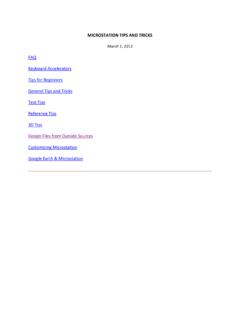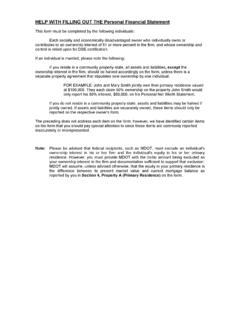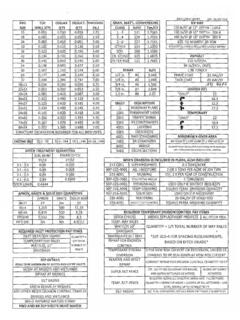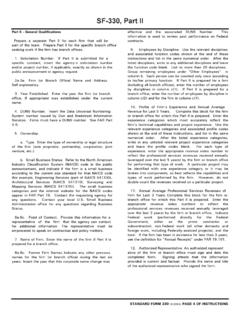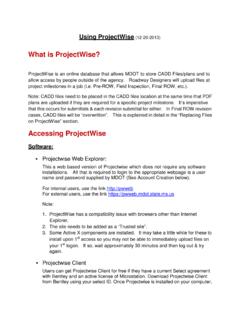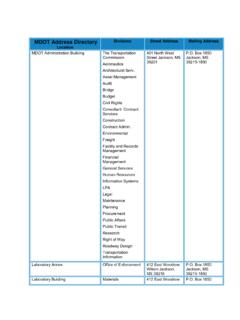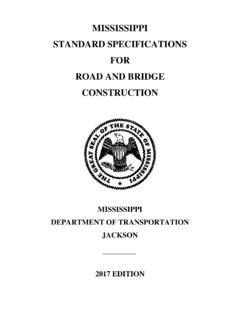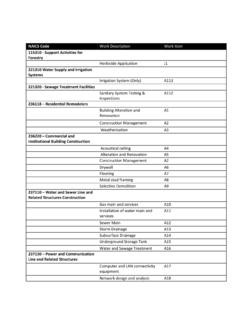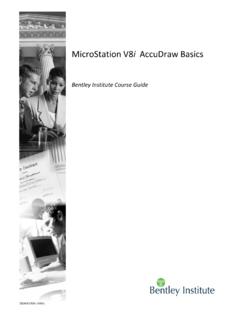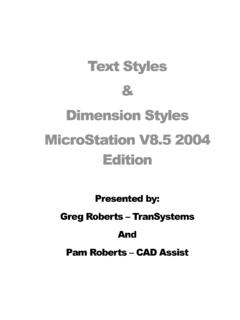Transcription of MACROS AND USER COMMANDS - Mississippi
1 MACROS AND user COMMANDS Introduction The following chapter documents the basic functions of the current programs known as microstation MACROS and user COMMANDS . MACROS and user COMMANDS are programming languages specific to microstation . user COMMANDS (.ucm) files are ASCII files that contain instructions that perform as series of task. user COMMANDS are no longer fully supported by Bentley microstation . The full functionality of the language no longer works as orginally design. Many of the items that could be done with user COMMANDS are no longer valid. Although the more simple task they performed still continue to function. Some of Roadway Design s programs are still in the .ucm format and will remain until that way until they no longer function or can be replaced with a newer language.
2 user COMMANDS do not require any program compliers and are read by microstation in their original ASCII format by entering the key in command (uc=<ucmName>. MACROS are another special microstation programming language that can be similarly compared to a BASIC programming language. Most of the macro language is still supported by microstation , although Bentley recommends that MACROS be replaced with the latest VBA programming language. Roadway converted most of their user COMMANDS to the macro language and still continues to use a large number of custom MACROS . MACROS start out as source code written in an ASCII file (.bas) and then is compiled when it is activated in microstation to create a (.ba) file. The (.))
3 Ba) compiled file, can be ran in microstation without the presence of the source file (.bas), but the .ba file is a binary file which cannot be modified. Therefore providing the author a way to protect or secure it from being modified. Currently Roadway does not provide the source files with the delivered data set. Most of these programs are called from custom Menus that Roadway Design provides in its delivered interface. The following show the general location the programs are called from and includes the program name and information about the function of the program. Running MACROS and user COMMANDS Manually All the MACROS and user COMMANDS listed in this document can be executed from within microstation with a key in.
4 MACROS Key In: macro <macro_name> Where <macro_name> is the name of the basic macro as listed in this document. It is not necessary to put the .ba extension on the name, because microstation will automatically look for the .ba file. The macro must have the full directory path listed with the name unless you have assigned the variable ??? to equal the directory where you have placed the macro files. The workspace used by Roadway design currently points this variable to our group directory. user COMMANDS Key In: uc=<user_command_name> Where <user_command_name> is the name of the command as listed in this document. It is not necessary to put the .ucm extension on the name, because microstation will automatically look for the.
5 Ucm file. The user command must have the full directory path listed with the name unless you have assigned the variable MS_UCM to equal the directory where you have placed the files. The workspaces used by Roadway Design currently points this variable to our group directory. DZINE MENU You can used the links below to quickly locate a programs location on the menu. Existing Proposed Labels Elements Fence Reference Sheets Plotting Menus Angles View File Utilities Other Some COMMANDS are activated manually. To see a description of these COMMANDS and other miscellaneous command go to the subject: Other Subroutines Some COMMANDS are called by other COMMANDS and are not located on the menu. These are called: Subroutine COMMANDS .
6 If you see an option missing above it is because there is no program used under that option on our menu. macro AND user command DOCUMENTATION EXISTING > EXISTING > TRANSPORTATION FEATURES > X-TRANS NAME: TITLE: DRAW EXISTING EDGES OF PAVEMENT Description Sets the parameters to draw existing edges of pavement. The user needs to use the standard microstation COMMANDS to draw the edges of pavement. NAME: TITLE: DRAW EXIST. EDGES OF PAVEMENT LINES BY COPIED PARALLEL ELEMENT Description Allows the user to copy an element parallel at a user defined distance with the new element placed with the new symbology set for existing edges of pavement lines. NAME: TITLE: DRAW EXIST. AREA PATTERN FOR REMOVAL OF ASPHALT Description Allows the user to pattern an area with cross hatching for removal of asphalt pavement.
7 The command sets the level and symbology and pattern settings automatically. The pattern scale is set to a size that can be used on any plot scale, but the user has the option to change the pattern scale. The command defaults to the pattern area points command , but again the user has the option to change the pattern method. NAME: TITLE: DRAW EXISTING SHOULDER LINES Description Sets the parameters to draw existing shoulder lines. The user needs to use the standard microstation COMMANDS to draw the shoulder lines. NAME: TITLE: DRAW EXIST. SHOULDER LINES BY COPIED PARALLEL ELEMENT Description Allows the user to copy an element parallel at a user defined distance with the new element placed with the new symbology set for existing shoulder lines.
8 NAME: TITLE: DRAW EXISTING DRIVEWAYS Description Sets the parameters to draw existing driveways. Existing driveways have the same settings an existing edges of pavement ( ). NAME: TITLE: DRAW EXISTING CURB Description Sets the parameters to draw existing curb. NAME: TITLE: DRAW EXISTING SIDEWALK Description Sets the parameters to draw existing sidewalk. NAME: CALLS: , TITLE: DRAW EXISTING ROADWAY RETAINING WALLS Description Sets the parameters to draw existing roadway retaining walls. The user needs to use standard microstation COMMANDS to draw. NAME: TITLE: DRAW EXISTING BRIDGES Description Sets the parameters to draw existing bridges. NAME: TITLE: DRAW EXISTING BOX BRIDGES Description Sets the parameters to draw existing box bridges.
9 NAME: TITLE: PLACE BRIDGE TICS ON CORNERS OF EXISTING BRIDGES. Description This places a tic mark representing the corners of existing bridges. Notes: 1. It will not work entirely correct on curved bridges. It will place the tics, but they will not be orientated in the right direction. The user can use modify COMMANDS to adjust the tics. 2. The corners of the bridge must be identified in a counter-clockwise direction. 3. The first two corners identified must be along the bridge rail to insure that the symbols are place correctly on a bridge that has skewed abutments. EXISTING > TRANSPORTATION FEATURES > ALIGNMENTS NAME: TITLE: PLACE EXISTING TRANSPORTATION ALIGNMENTS - MAINLINE STATIONS Description Used to place label lines and text for Existing Transportation Alignment Mainline Stations NAME: TITLE: PLACE EXISTING TRANSPORTATION ALIGNMENTS - MAINLINE LABELS Description Used to place label lines and text for Existing Transportation Alignment Mainline NAME: TITLE: PLACE EXISTING TRANSPORTATION ALIGNMENTS - MAINLINE CURVE DATA Description Used to place label lines and text for Existing Transportation Alignment Mainline Curve Data NAME: TITLE.
10 PLACE EXISTING TRANSPORTATION ALIGNMENTS - SECONDARY STATIONS Description Used to place label lines and text for Existing Transportation Alignment Secondary Stations NAME: TITLE: PLACE EXISTING TRANSPORTATION ALIGNMENTS - SECONDARY LABELS Description Used to place label lines and text for Existing Transportation Alignment Secondary Labels NAME: TITLE: PLACE EXISTING TRANSPORTATION ALIGNMENTS - SECONDARY CURVE DATA Description Used to place label lines and text for Existing Transportation Alignment Secondary Curve Data NAME: TITLE: PLACE EXISTING TRANSPORTATION ALIGNMENTS - AUXILIARY STATIONS Description Used to place label lines and text for Existing Transportation Alignment Auxiliary Stations NAME: TITLE: PLACE EXISTING TRANSPORTATION ALIGNMENTS - AUXILIARY LABELS Description Used to place label lines and text for Existing Transportation Alignment Auxiliary Labels NAME: TITLE: PLACE EXISTING TRANSPORTATION ALIGNMENTS - AUXILIARY CURVE DATA Description Used to place label lines and text for Existing Transportation Alignment Auxiliary Curve Data NAME: TITLE: PLACE EXISTING TRANSPORTATION ALIGNMENTS - LOCAL ROAD STATIONS Description Used to place label lines and text for Existing Transportation Alignment Local Road Stations NAME: TITLE.
